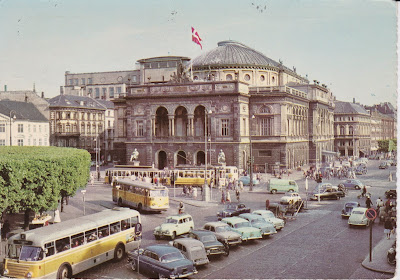Royal Danish Theatre
The Danish architect, Jens Vilhelm Dahlerup, specialized in the Historicist style and designed the theatre plus several other buildings many of which have become landmarks. He is said to have contributed to the way Copenhagen appears today more than any other single architect. Dahlerup also was a jury member for both the 1876 Philadelphia World’s Fair, the 1878 World’s Fair in Paris and was the house architect of Tivoli Gardens.
The two light brown stamps on the card labeled Dansk Fredning (Danish Preservation) were used in the 1960s and helped to date the card. The upside-down purple-rose stamp was issued in 1962 to commemorate the 150th anniversary of the birth of John Bernhard Georg Carstensen (1812-1857) one of the developers of the famous Tivoli Gardens in Copenhagen, Denmark and a Danish army officer. He served during the war at Schleswig and when he returned he found that his construction contract had expired and he was no longer needed for the work on Tivoli. He then left for an army post in the Danish West Indies. He was married to the daughter of an island planter. Later he traveled to New York where he also designed the New York Crystal Palace together with the German architect Charles Gildemeister as part of the Exhibition of the Industry of All Nations fair in 1853. In 1855 he attempted to build a rival to Tivoli Gardens that he called the Alhambra in Frederiksberg, Denmark. The project failed and is only remembered by a street named Alhambravej. Carstensen died at age 44 in 1857 and is buried in Garnison’s Churchyard in Copenhagen.
For more information, please see:
http://en.wikipedia.org/wiki/Royal_Danish Theatre
http://en.wikipedia.org/wiki/Georg_Carstensen
http://en.wikipedia.org/wiki/Vilhelm_Dahlerup


No comments:
Post a Comment